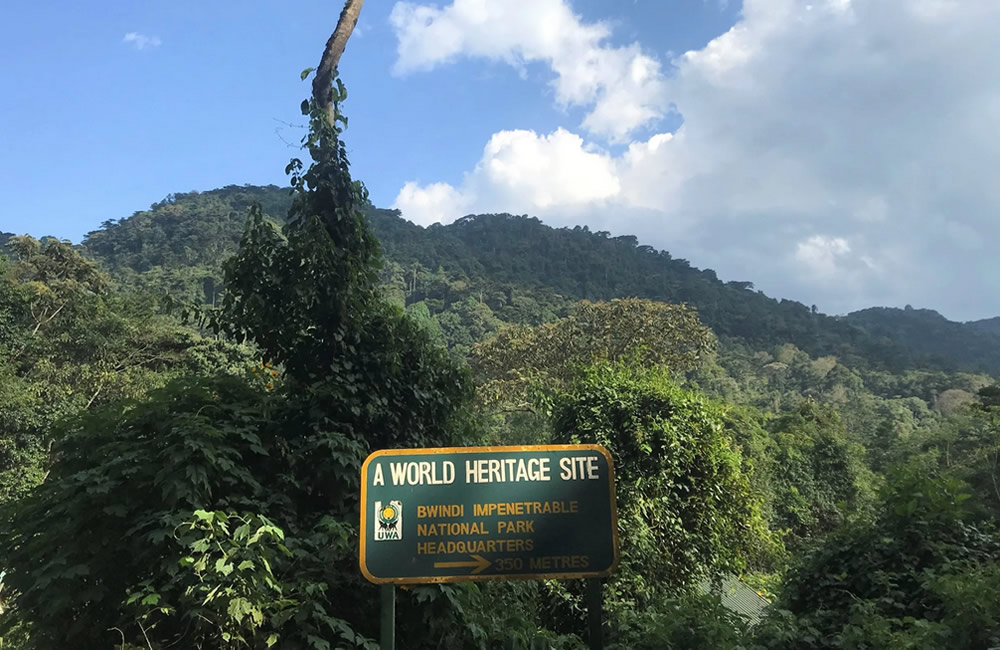Down in the remote south western corner on the border of Rwanda and the Democratic Republic of Congo lies the mountain Gorilla home, which is Uganda’s premier tourist destination. This park is set in a regional landscape of melodramatic and variety of life which has attracted many tourists to come for gorilla tours to Uganda. But while zoologists and botanists marvel at endless species counts, most visitors are dragged by just one animal; the mighty mountain gorilla. This endangered primate has a total population of less than 1000 members and lives only in the impenetrable forests of Bwindi and the Virunga Mountains; in only three national parks – Volcanoes National Park of Rwanda, Virunga National Park of DR Congo and Mgahinga Gorilla National Park. The largest population lives in Bwindi national park making Uganda an outstanding location to search for these magnificent apes.
Gorilla tracking in Uganda
This is one of the world’s most exclusive and remarkable wildlife encounters. To minimize disturbance to these endangered great apes, only eight people may track each of the habituated gorilla family on a single day, while viewing time is strictly limited to one hour. As wildlife viewing goes, it is difficult to convince how or where on earth 60 minutes could be more rewardingly spent. Gorilla trekking offers the privilege of encountering one of the world’s rarest animals in its natural habitat and, by doing so, helping to fund its continued survival.
Although mountain gorillas are undisputedly intelligent and impressive creatures to watch – a silver-back can weigh over 200kg, the greatest rewards are less tangible. The mountain gorilla is one of our closest relatives and few observers emerge from the magic hour without feeling an unfathomable and often profoundly moving connection.
Bwindi impenetrable National Park has a unique wildlife experience. Biologically, the Bwindi impenetrable National Park is one of Africa’s richest forests, owing to its great age and an altitudinal range spanning 1400 meters. There is an impressive list of species, with 200 different trees, 350 birds, 310 butterflies, 88 moths, 51reptiles and 120 mammals including several primates, among them chimpanzees, black and white colobus, blue monkeys, grey checked Mangabey, L’Hoest’s monkey and the star attraction, the mountain gorilla. Bwindi has 10 habituated Gorilla groups, which are tracked from four trailheads. Eight permits are available for each group, giving a daily maximum of 80 permits. Trekking the mountain gorilla takes two to eight hours depending on the location of the group.
This adventure also requires a reasonable level of fitness, as the impenetrable forest is well named. The gorilla’s homeland comprises dense, tangled vegetation on a mountainous landscape of deep valleys and steep ridges.
Bird diversity in Bwindi Impenetrable National Park
Bwindi offers some of the finest montane forest bird watching in Africa, and is a must see destination for any serious birder visiting Uganda. There is an estimated 350 bird species with 23 endemic to the Albertine Rift and 14 recorded nowhere else in Uganda. Globally threatened species such as African Green Broadbill and Shelley’s Crimsonwing are also found here. Other birds include the African Broadbill, Black-billed Turaco, Black and Cinnamon-chested Bee-eaters, Purple-breasted, Western Green Tinkerbird, Blue-headed and Regal Sunbirds; Handsome Francolin, Short-tailed and Black-faced Rufous Warblers, Mountain and Yellow-streaked Greenbuls, Mountain-masked and Collared Apalis, and Many-colored Bush-Shrike, among others.
The famous Bwindi impenetrable national park also home to over 25 amphibian species. 11 of which are endemic to the Albertine Rift. Six are of global conservation concern including the Western Rift Leaf-folding Frog (Afrixalus orophilus) and Ahl’s Reed Frog (Hyperolius castaneus).
Fourteen snake species, 9 of which are endemic to Bwindi are known to be thriving here, Six species of chameleon, 14 species of lizards have also been recorded.
Butterfly species in Bwindi Impenetrable National Park Uganda
Bwindi shelters over 220 butterfly species including 8 Albertine rift endemics. Three butterflies occur only in Bwindi: the Cream- banded swallowtail (Papilio leucotaenia), Graphium gudenusi and Charaxes fournierae. The threatened African giant swallowtail (Papilio antimachus) is also found in Bwindi.
Floral diversity in Bwindi Impenetrable National Park
The Bwindi Impenetrable Forest is old, complex, and biologically rich. Diverse species are a feature of the park and it became a UNESCO World Heritage Site because of its ecological importance. Among East African forests, Bwindi has some of the richest populations of trees, small mammals, birds, reptiles, butterflies, and moths. The park’s diverse species are partly a result of the large variations of elevation and habitat types in the park, and may also be because the forest was a refuge for species during glaciations in the Pleistocene epoch.
The park’s forests are afro Montane, which is a rare vegetation type on the African continent. Located where plain and mountain forests meet, there is a continuum of low-altitude to high altitude primary forests in the park, one of the few large tracts of East African forest where this occurs. The park has more than 220 tree species, (more than 50 percent of Uganda’s tree species) and more than 100 fern species. The brown mahogany is a threatened plant species found within the park.

Leave a Reply